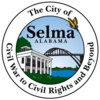
Back Selma, Alabama Afrikaans سلما Arabic سلما ARZ سلما، آلاباما AZB Selma (Alabama) Catalan Сельма (Алабама) CE Selma (kapital sa kondado) CEB سێلما، ئەلاباما CKB Selma, Alabama Welsh Selma (Alabama) Danish
Selma, Alabama | |
|---|---|
| City of Selma | |
From top, left to right: St. James Hotel and Water Avenue; Edmund Pettus Bridge; National Voting Rights Museum and Institute | |
| Nickname(s): Queen City of the Black Belt, Butterfly Capital of Alabama | |
 Interactive map of Selma | |
| Coordinates: 32°24′59″N 87°1′29″W / 32.41639°N 87.02472°W[1] | |
| Country | United States |
| State | Alabama |
| County | Dallas |
| Founded | 1815 |
| Incorporated | 1820 |
| Government | |
| • Type | Mayor–Council |
| • Mayor | James Perkins Jr. (D) |
| Area | |
• Total | 14.40 sq mi (37.30 km2) |
| • Land | 13.81 sq mi (35.77 km2) |
| • Water | 0.59 sq mi (1.54 km2) |
| Elevation | 135 ft (41 m) |
| Population | |
• Total | 17,971 |
| • Density | 1,301.40/sq mi (502.46/km2) |
| Demonym | Selmarian |
| Time zone | UTC−6 (CST) |
| • Summer (DST) | UTC−5 (CDT) |
| ZIP Codes | 36701-36703 |
| Area code | 334 |
| FIPS code | 01-69120 [1] |
| GNIS ID | 163940 [1] |
| Website | selma-al.gov |
Selma is a city in and the county seat of Dallas County,[1] in the Black Belt region of south central Alabama and extending to the west. Located on the banks of the Alabama River, the city has a population of 17,971 as of the 2020 census.[3] About 80% of the population is African-American.
Selma was a trading center and market town during the antebellum years of King Cotton in the South. It was also an important armaments-manufacturing and iron shipbuilding center for the Confederacy during the Civil War, surrounded by miles of earthen fortifications. The Confederate forces were defeated during the Battle of Selma, in the final full month of the war.
In modern times, the city is best known for the 1960s civil rights movement and the Selma to Montgomery marches, beginning with "Bloody Sunday" in March 1965, when unarmed peaceful protesters were assaulted by County and state highway police.
By the end of March 1965, an estimated 25,000 people entered Montgomery to press for voting rights. This activism generated national attention for social justice. That summer, the Voting Rights Act of 1965 was passed by Congress to authorize federal oversight and enforcement of constitutional rights of all American citizens.
Due to agriculture and industry decline, Selma has lost about a third of its peak population since the 1960s. The city is focusing on heritage tourism, to build on its role as a major influence in civil rights and desegregation.
Selma is one of Alabama's poorest cities, with an average income of $35,500, which is 30% less than the state average. One in every three residents in Selma lives below the state poverty line.
- ^ a b c d e "Selma, Alabama", Geographic Names Information System, United States Geological Survey, United States Department of the Interior
- ^ "2020 U.S. Gazetteer Files". United States Census Bureau. Retrieved October 29, 2021.
- ^ a b "Selma city, Alabama - Census Bureau Search". United States Census Bureau. Retrieved August 26, 2022.




